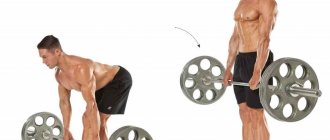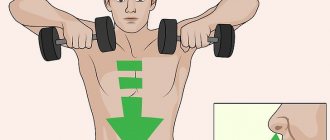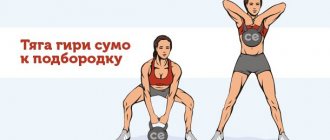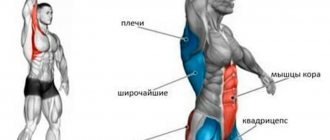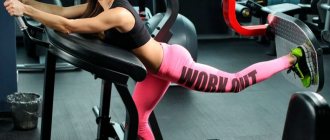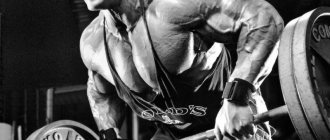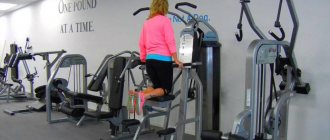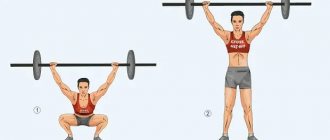The one-arm dumbbell row is one of the truly effective exercises for training your back muscles. Like other traction movements in a horizontal position, it is aimed at increasing the thickness of the back muscles. The ideal option would be to perform single dumbbell rows after pull-ups or vertical block rows in the list of exercises to strengthen the back muscles.
The benefits and disadvantages of dumbbell rows
The undoubted benefit of the one-arm bent-over row is that it is one of the best isolation exercises:
- Firstly, the athlete does not need to be distracted and waste energy on fixing the body, as when pulling two dumbbells or a barbell to the belt, because this exercise is performed while resting on a bench.
- Secondly, it is much easier to adjust the tilt of the back; all you need to do is bend your knee more while performing the deadlift. This allows you to emphasize the load on any part of the back muscles.
- Thirdly, this version of the deadlift helps create a V-shaped back, improves posture and expands the shoulder girdle.
- It is also worth mentioning the fact that due to the development of the latissimus muscles, strength indicators in basic exercises, such as barbell presses or deadlifts, increase.
- This exercise helps correct scoliosis.
- The one-arm bent-over row is a universal exercise, since in addition to a powerful contraction, it stretches the muscles at the lower point of the amplitude.
- The exercise is suitable for any athlete who has no contraindications to training.
Exercise technique
A competent technique for performing dumbbell rows with one hand, observed in all details, is the key to success in any sports discipline, be it bodybuilding, powerlifting or functional training. It is especially important for CrossFit athletes to follow the one-hand dumbbell row technique. This is due to the fact that most of them try to perform exercises in the most explosive style possible in order to fit them into a shorter time interval.
However, we strongly recommend making an exception for one-arm dumbbell rows while standing in a bent-over position. Because any technical error can lead to serious consequences, harm your health and nullify any of your progress.
Initial position
Take a dumbbell and take the correct starting position. You can perform one-arm dumbbell rows by placing one hand and knee on a flat bench while tilting your body down almost to a right angle. This way the load will be focused on the lower part of the latissimus muscles.
Another option is a dumbbell row while standing with both hands alternately. In this case, you need to lean one hand on a dumbbell rack or other height, put your foot forward and move your pelvis back a little, maintaining a torso tilt of about 45 degrees. This position will work more on the upper lats, as well as the rhomboids and rear deltoids. Decide in which position you feel the work of your back muscles better, or alternate these options at each workout.
Attention to your back
Whatever body tilt option you choose, the technical features of the movement will be the same. Keep your back straight, your gaze directed forward, and do not round your thoracic spine. It is permissible to use an athletic belt when working with serious weights, as well as wrist straps or hooks if you want to remove the maximum load from your biceps and forearms.
Dumbbell lift
Start lifting the dumbbell upward while exhaling. The movement should be made in a slight arc. The dumbbell not only rises up, but is also pulled towards the belt - this way the load on the latissimus dorsi muscles will be at its peak. Try not to use your biceps; to do this, concentrate on moving your shoulder blades. Our task is to raise the shoulder blade as high as possible and move it slightly towards the center. At the same time, the elbow should be located slightly above the level of the ribs.
Reverse movement
Take a short pause in the top position, trying to “squeeze” the working muscle as much as possible. Then gently lower the dumbbell down, inhaling and stretching the working muscle. You need to lower the dumbbell under control, without relaxing your lats and without “dropping” the dumbbell down. In the lower position of the projectile, we also take a short pause, slightly relaxing the shoulder blade and hand in order to stretch the muscle fascia as much as possible. After this, we perform one more repetition.
What muscles work when bent over dumbbell rows?
When performing deadlifts, the latissimus dorsi muscle is maximally involved in the work.
Other back muscles are also involved in the work, namely the rhomboid, trapezius, spinal extensors, as well as the posterior deltoid, abdominal muscles and biceps.
General information
It is one of the main exercises that helps increase the volume of the back muscles and give relief. In addition, as a result of regular and correct execution of the exercise, the athlete’s strength increases.
Performing the exercise involves several options
One of the most significant advantages of this exercise is its ease of implementation. You can train muscles in this way without complex devices and simulators. To perform the exercise, a bench and dumbbells are enough. In some variants, athletes refuse the bench.
Also, performing this exercise has a number of undeniable advantages:
- Does not allow you to overstrain or injure your wrist;
- Reduced load on the spine compared to using a barbell;
- Makes it possible to correct muscle asymmetry (when the muscles of one side are more developed than the other);
- Forms a V-shaped figure;
- Increases strength and endurance.
Unlike a similar exercise performed with a barbell, the dumbbell row allows you to focus on each side. In this case, the weight and load can be adapted for each hand.
It is important! Exercise not only allows you to significantly increase the volume and definition of your back muscles, but also helps reduce the time it takes to achieve a visible effect.
One-arm dumbbell row technique while resting on a bench
So let's look at the right side bent over row. First you need to take your starting position, standing to the left of the bench.
- The palm is turned towards the thigh.
- The torso should be tilted parallel to the bench, and the back should be slightly arched at the lower back.
- The hand with the dumbbell is perpendicular to the floor. The muscles are relaxed, the shoulder is slightly lowered and stretched as much as possible.
- After exhaling, tensing the latissimus muscle, the athlete pulls the dumbbell to the thigh as high as possible. The dumbbell should not rise above the level of your back.
- At the top point of the movement, the dumbbell should be held for a short time, and then the sports equipment should be returned to its original position while inhaling.
Useful tips
Let's look at a few important technical details that will help you get the full benefit from this exercise:
- The weight of the dumbbell should be such that it does not pull you along with it when lowering. The thoracic spine should remain in a stable position. There should be no bending downwards under the weight of the dumbbell.
- The one-arm dumbbell row allows for a little cheating on the final reps. But make sure that the dumbbell does not go through the entire positive phase of movement by inertia and does not fall down uncontrollably - this greatly increases the axial load on the spine.
- Circular rotation of the shoulders when lifting the dumbbell upward is unacceptable. If you want to overcome the last few centimeters of amplitude by rotating your shoulders, then the weight of the dumbbell is too heavy for you.
- From time to time we should add a little variety to this exercise to shock our muscles in a new way. You can slightly tilt the dumbbell towards yourself or rotate it 90 degrees when overcoming the last 15-20 cm of amplitude. This will give your muscles an additional boost to growth.
- Be sure to bring the dumbbell movement to your waist. If you pull straight up, you will deprive the latissimus dorsi of most of the contraction, leaving the rear deltoids, biceps, and trapezius to do most of the work.
Recipes for healthy eating
White fish (hake, pollock, loach), stewed with vegetables
- 6.3 g Protein
- 8 g Fat
- 6.4 g Carbohydrates
- 120 kcal
60-90 minutes
- #bell pepper
- #dietary
- #greenery
- #low calorie
- #dinner
- #roasting
- #fish
- #sour cream
- #dinner
- #purple onion
Other recipes
One-arm bent-over row with emphasis on the leg
Performing the exercise with emphasis on the leg is identical to the previous one, however, with this option, the back is not parallel to the floor, as with a bench, its inclination is 45 degrees.
- When pulling with an emphasis on the thigh, the athlete fixes the position with the emphasis of the arms and legs.
- The supporting leg should be bent at the knee, and the other leg should be set back.
Otherwise, the exercise is performed identically to the option of bending over on a bench.
Classic
The correct technique for performing an exercise is the key to success in every discipline. Regardless of what direction a person has chosen - bodybuilding, functional training or triathlon, in order to achieve good results he should not neglect the rules of execution.
Technique is especially important for athletes who do CrossFit. This is explained by the fact that such people try to do deadlifts with explosive force in order to complete the approach as quickly as possible. In fact, this option is erroneous. It can lead to serious consequences, due to which health will deteriorate significantly and progress will decrease.
A standard one-arm dumbbell row on a bench is done like this:
- Take the projectile in one hand with a neutral grip.
- Place the knee opposite your working hand on the bench and rest your other hand on it.
- The supporting hand must be positioned clearly under the shoulder, the back straight.
- As you inhale, tense your back and deltoid muscles as much as possible, and pull your arm with the projectile up.
- When the elbow reaches shoulder level, it is necessary to engage the shoulder joints, contracting the muscles of the middle and upper back.
- At the highest point, the elbow should be pointed straight up, and the hand on the dumbbells should be kept at waist level.
- You need to hold this position for a couple of seconds.
- Smoothly return to the starting position.
Having finished performing the exercise with one hand, you immediately need to transfer the projectile to the other and do all the same actions again with it. One approach involves working with both hands. In this case, you need to change sides completely, resting on the bench with your other hand and foot.
One-Arm Kettlebell Row
This option is suitable for those athletes who do not have the opportunity to exercise with a dumbbell. The disadvantage of kettlebells is the lack of weight variation , that is, the athlete in most cases has the opportunity to work with weights of 8, 16, 24 and 32 kilograms. By the way, you can perform the exercise either on a bench or with emphasis on the thigh. Otherwise, the exercise is performed in exactly the same way as when rowing a dumbbell on a bench.
Without support
The second version of the deadlift is performed without a bench. This exercise is also very effective, but it must be done extremely carefully, since here the risk of back injury almost doubles. The technique is as follows:
- Stand straight and place your feet shoulder-width apart.
- Place the projectile next to one of the lower limbs.
- Bend your legs slightly, bend your back straight and take a dumbbell in one hand, placing the other on your lower back.
- Bend your working arm, bringing your elbow up.
- Bring the projectile to the waist, feeling the tension in the muscles.
- Return to starting position.
An alternative to this exercise is the bench row. This option is more suitable for girls and boys who have not previously played sports and have weak muscles. Having learned to perform this exercise correctly, they can easily begin the classics. It is done this way:
- Incline the bench to 45 degrees.
- Lie on your stomach.
- Lower your hands down and take a dumbbell in each.
- Synchronously or alternately pull the projectiles to the lower back.
Recommendations for implementing 1 dumbbell back row
- When performing bent-over rows, do not assist your muscles or use inertial force.
- Try to perform the exercise smoothly, slowly and concentrated.
- Don't round your back. Always control the arch in your lower back. Also keep your chest up.
- Don't round your mid-back.
- The torso should not rotate when working with weights.
- The exercise should be included in the training process after vertical block rows or pull-ups.
- For men, the optimal number of approaches is 3-4, depending on the athlete’s physical fitness. The rep range is 8 to 12. You should also do one warm-up set with a light weight.
- For women , a standard training scheme is suitable, in which the exercise is done either solo or in a superset. The number of approaches does not exceed three, 15-25 repetitions.
Mode
Having chosen the option of performing dumbbell rows to the thigh, you should determine the intensity. This moment also plays an important role, because progress in training depends on it.
Representatives of the stronger sex need to perform about 4 sets of 8 to 10 repetitions in order to build muscle. To progress without stopping, it is best to alternate sets and takes. This means working at an intense pace one week and reducing the number of dumbbell lifts the next. Changing the types of traction will also benefit. Beginners should alternate the classic one-arm row with an exercise performed on a bench with two arms. As for more experienced athletes, it is best for them to perform standard deadlifts for a while, and then bent over, but only without support and with one hand.
Fragile girls are allowed to perform both options at once. For them, as mentioned above, synchronized rowing with two hands is suitable for warming up, and immediately after that they can perform a classic exercise. In the first case, the number of repetitions should be almost twice as large as in the second. It is better for ladies not to perform deadlifts without support with one hand.
Simulators for similar movement
Bent over rows of free weights can be replaced with exercises in machines that work the same muscle groups.
Smith machine
Bent-over rows are safe to perform in a Smith machine. The rod moves along vertical guides and is secured with safety locks.
Use the same technique when performing the exercise in a Smith machine as with a regular barbell.
T-bar row
The T-bar is fixed to the floor at one end, and plates from the bar are suspended from the other. Instead of the simulator itself, you can pull the barbell in this position, resting it in a corner.
- Place the T-bar between your legs. Bend your torso, knees slightly bent. Raise the T-bar slightly off the floor - this is the starting position.
- Pull the bar toward your chest. At the top, pause and squeeze your shoulders together. Lower the bar to the starting position.
Pulling the block to the belt
Instead of performing standing rows, beginners can include seated rows in their workout.
- Select the weight to lift and sit on the machine bench. Place your feet in a special position, knees slightly bent.
- Tilt your body forward and grab the handles, palms facing each other. Tilt your body back so that your back is perpendicular to the floor and your arms are straight - this is the starting position.
- Pull the handles of the exercise machine towards your stomach and lean back slightly. In this position, squeeze your shoulder blades together to tighten your back muscles. Extend your arms and return the handles of the machine to the starting position.
Read more about block traction in the article.
Bent-over rows with harnesses
Place a rubber band on the floor and stand on it with your feet hip-width apart.
- Take the right end of the tourniquet with your left hand, and the left end with your right hand, so as to cross the tourniquet. Knees slightly bent, lean your body forward. The back should be straight and parallel to the floor.
- Straighten your arms under your shoulders, turn your palms towards your feet. The tourniquet sags in this position. As you exhale, pull the handles of the tourniquet towards your chest. Stay in this position, tighten your back muscles. Lower your arms down as you inhale.
For more exercises with harnesses, see the article.
Common mistakes
- Dumbbell row to chest. The back does not work, the load goes to the deltoids. Perform rows to the waist or to the stomach.
- Lifting the projectile by turning the body. It's better to take a lighter weight, but keep your torso fixed.
- Rounding the back. Keep your back straight and your lower back arched.
- Moving your elbow to the side also reduces the effectiveness of the exercise. The elbow should move back and up. The hand seems to slide along the body.
- Tilt your head down. This makes it difficult to keep your back straight.
- Jerking movements. Lead to injury.
Now watch the video to finally consolidate your knowledge.
Now you know how to lift dumbbells correctly. That's all I have for today. Subscribe to articles and share useful information on social networks.
Who is not recommended to do this exercise?
Although exercise is beneficial, it is always worth remembering that each person has differences in physical abilities. Therefore, before starting regular training, you should check your health in order to know exactly which exercises can be performed calmly, and which ones are best replaced with others. This should definitely be done, since timely detection of problems will help avoid various injuries and complications.
Bent-over rows of one or two dumbbells are not recommended for the following people:
- For those who have problems with the rear delts. Since they will be constantly involved during the exercise. And if a person does this exercise despite contraindications, he may get complications.
- People with poor stretching and flexibility. It will be very difficult for unprepared people from the very beginning. Because of this, technique will suffer, and lack of flexibility can lead to damage to muscle tissue. Therefore, before starting this exercise, you should do flexibility exercises for several weeks.
Thus, dumbbell rows are one of the most effective and simple exercises aimed at pumping the back muscles. Depending on the angle of the torso, different areas of the back are pumped. In addition to the fact that it allows you to pump up all the back muscles, it has a beneficial effect on posture and helps tighten your arms. If it is performed incorrectly and the arms are pulled to the chest and not to the belt, then you can simply pump up the muscles of the arms and shoulders.
Therefore, it is mainly used as a main exercise. Also, if one of the execution techniques is boring, then it can be replaced with another without losing anything. This exercise does not require regular visits to the gym; it can be performed at home. It is ideal for both boys and girls.

